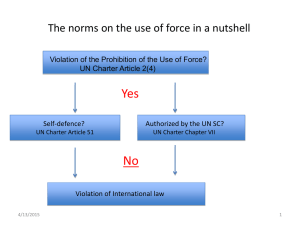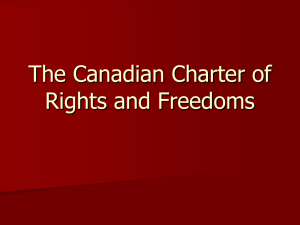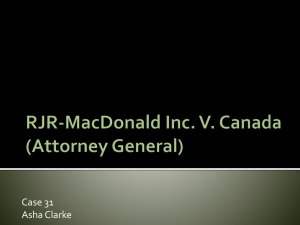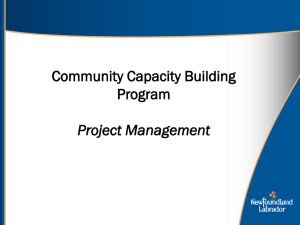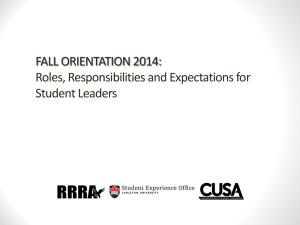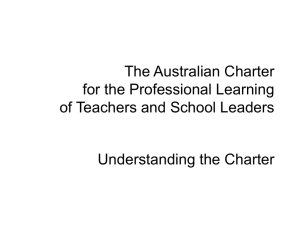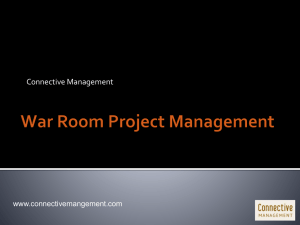slides
advertisement
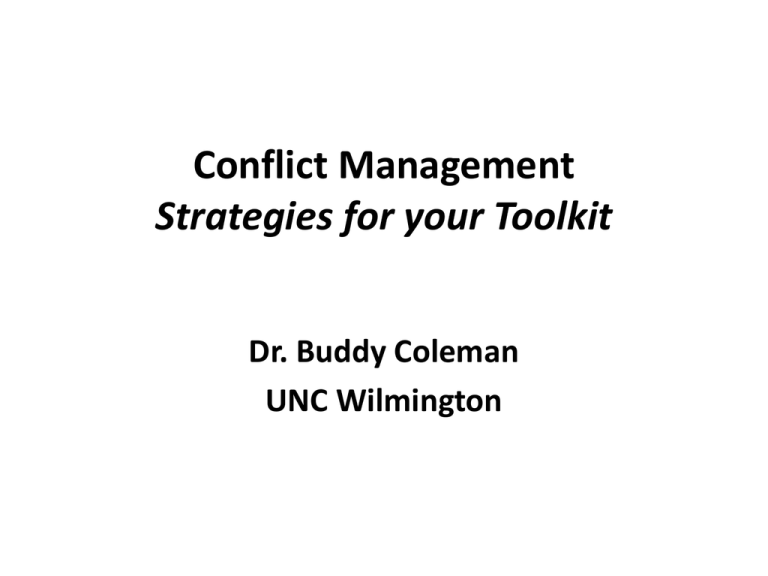
Conflict Management Strategies for your Toolkit Dr. Buddy Coleman UNC Wilmington Strategies for Your Toolkit • Strategy 1: Avoid Emotional High Jacking • Strategy 2: Prevent Conflict • Strategy 3: Resolve Conflict Sequential Process Strategy 1 Strategy 2 Strategy 3 Strategy 1 – Most Important One Avoid becoming emotionally high jacked • Do not emotionally high jack ourselves • Do not allow others to high jack us http://www.youtube.com/watch?v=TGBTkREbXfY Avoid High Jacking Ourselves • Psychodynamic Leadership Theory – Hardwired neurological pathways; aggression and emotional states are driven by the medulla oblongata in our brains – Behavioral patterns – Personality development • Preferences & Orientations – Comfort Zone: what we like rather than dislike – Needs based: satisfying our needs – Resist modifying our behaviors – Doing what we “want to do” – Instead of what we “should do” Do Not Allow Others to High Jack Us • People who are in control of their emotions are in control • Resist giving in to physiological and psychological comfort zone responses • Do not take the “bait” when people and/or situations set off our emotional triggers • Emotional triggers are usually developed from childhood and are our “hot buttons” that can cause us to lose control and overreact Effective Charter Leaders • Operationally defined as individuals who live, work and perform at their very best • They accomplish this by being keenly aware of their strengths and weaknesses • Most importantly, they modify their thinking, behaviors and decisions to think, analyze, listen and “take the high ground” rather than undermining themselves emotionally Emotional Intelligence • • • • Understanding ourselves personally Understanding our strengths and weaknesses Maintaining an effective leadership orientation We are no longer leaders once we become emotionally high jacked • Effectiveness of our actions and decisions are determined by the reactions Emotional Triggers • Defined as behaviors and situations that may cause us to respond more emotionally than rationally • Usually related to childhood events, parental relationships and/or deep feelings about loved ones • The emotional triggers stimulate the medulla oblongata in our brains and result in a “flight” or “fight” response • Example of an emotional trigger http://www.youtube.com/watch?v=_ZpDnXYIFjo Emotional Triggers • What kind of things do people do that you dislike? • What are your feelings towards people when they do things that you dislike? • What are some of your emotional triggers? Strategy 2: Prevent Conflict • First we must implement Strategy 1 by always taking the high ground and avoiding being emotionally high jacked by ourselves or others • Second, we must establish agreements based on purpose, mission and goals relative to behaviors and interactions for all charter school stakeholders • Principal/Director, Board Members, Teachers, Parents, Students and Staff • Staff development for Principal and Board Members is critical and should include personality inventories to promote understanding among charter school leaders Preventing Conflict • Establish behavioral agreements for discussions, interactions and decision making • These must be in alignment with charter school mission, purpose and goals • Behavioral agreements must also be congruent with the roles of principal, board members, teachers and parents. • Charter school leaders must focus on managing the interpersonal dynamics of all charter school stakeholders Preventing Conflict • Establish and commit to agreements • Written guidelines for interaction • Types of agreements include: – Communication – Behaviors – Assumptions – Trust – Feedback Example of Behavioral Agreements “We agree to… • • • • • • • • • Open, honest, & regular communication No silent disagreements Collaborate with each other…focus on win-win Anticipate opportunities and issues Assume positive Intent Respect each other Maintain confidentiality Keep our promises Provide immediate feedback to anyone who violates an agreement • Support each other to ensure a successful charter school Preventing Conflict • It our responsibility, as charter school leaders, to resolve interpersonal conflicts ASAP in meaningful ways relative to maintaining healthy relationships to work together to stay on point • Leaders must be able to understand and be able to deal with feelings, disagreements and issues • This is our responsibility Preventing Conflict • To be successful, charter school leaders must establish high quality, trusting personal relationships with their teachers, parents and board members • This is accomplished by: – Building relationships based on openness, expertise and a willingness to listen to the views, opinions, and priorities of your stakeholders – Maintaining an even-handed and controlled approach in all interactions. – Guiding stakeholders via personal interactions rather than positional authority and allowing time for them to process issues and decisions. Preventing Conflict • Board Members’ Roles – Preparation: Does the board have a clear sense of how it will conduct oversight of the academic program and fiscal health of the organization? • Board Members’ Abilities – Capacity and Composition: Does the board the have the skills and expertise to govern? • Board Members/Principal Governance – Structure: Is the proposed governance structure in line with best practice? – Clarity: Is there clear delineation of the authority and duties of the board, school leader, parents, teachers, and contractor, such as an education service provider (ESP) or a charter management organization (CMO)? Preventing Conflict • Charter school leader’s ability to maintain a professional, controlled orientation • Effectively use communication and listening skills to promote positive and constructive interactions • Establish formal structures and operationally define roles that are clearly understood Strategy 3: Resolving Conflict • First, Strategies 1 and 2 must be implemented • Next, if conflict occurs…or rather when conflict occurs, then we, as leaders, must take appropriate action to resolve the conflict in meaningful and positive ways • We begin by making sure that we understand conflict Resolving Conflict • • • • Is conflict good? Is conflict bad? Neither How we understand & respond to conflict is the key Resolving Conflict • • • • Avoid blame game Avoid getting emotional Do not take it personally Effective listening, understanding and communication skills • Make it clear you are there to help Resolving Conflict • Operationally defining conflict as a state of unresolved differences: – Within an individual – Between individuals – An individual and a group – Or two or more groups • Based on caring about something – Difficulty getting or giving something – Between two or more people, locked in an interdependent relationship – What one party does affects the other party Simplest Way to Resolve Conflict • Eliminate the relationship – Leave the interdependent relationship – Refuse to interact with the other person(s) • In many situations this is not practical • As charter school leaders, this is not usually possible • Therefore, we must learn how to address and deal with conflict Types & Sources of Organizational Conflicts • Interpersonal – Exists when people interact in ways to try and achieve goals and objectives – They have different attitudes, personalities, values, backgrounds and experiences • Competition for and/or management of resources – Limited resources – Resource decision making • Standardized Operating Procedures (SOPs) – Controls to manage behavior – Resistance to rules • Line-Staff Relationships – Authority issues – Resistance to control • Different Understandings of Goals Five Ways to Deal With Conflict 1. 2. 3. 4. 5. Denial/Avoid/Withdraw Positional Power Accommodation Compromise Collaborating Denial/Avoid/Withdraw Issues are not addressed • Use if – The issues or timing is not critical; a cooling off period is required for both parties; and more information is needed is needed to resolve conflict • Do not use if –The situation requires immediate attention or when one party remains frustrated by the avoidance of the issue Positional Power Authoritative • Use if – Swift action is needed in resolving the conflict • Do not use if - Concern for the parties involved is not clear and the consequences of the action taken have not been considered Accommodation Low on assertiveness, but high on cooperation • Use if – it will allow for a better position to be heard; the preservation of the relationship is more important than the issue; or, the most important one, you are wrong. • Do not use if – the issue is significant and must be resolved sooner than later Compromise Moderately cooperative and assertive • Use if – The issue or goal is of moderate importance and both parties involved feel a compromise would help in the resolution. • Do not use if – Only one party is willing to give up something. Negotiation is not possible. Collaborating Win-Win Approach • Use if – There are shared values or goals, time is available and the power among the parties is balanced; also if there is effective communication and the concerns are too important to compromise • Do not use if – There is no balance of power between the parties, the values and goals are not shared, or poor communication exists between the parties Charter School Conflicts • Tension among board members • Power, accountability and control: – Principal & Board – Principal, Board & Sponsoring District – Principal & Teachers – Principal & Parents – Teachers & Parents – Teachers & Students Conflict Situations Discussion • What are some conflict situations in your charter school? • What do you think is causing these conflict situations? Strategies for Your Toolkit • Strategy 1: Avoid Emotional High Jacking • Strategy 2: Prevent Conflict • Strategy 3: Resolve Conflict Sequential Process Strategy 1 Strategy 2 Strategy 3 Questions

